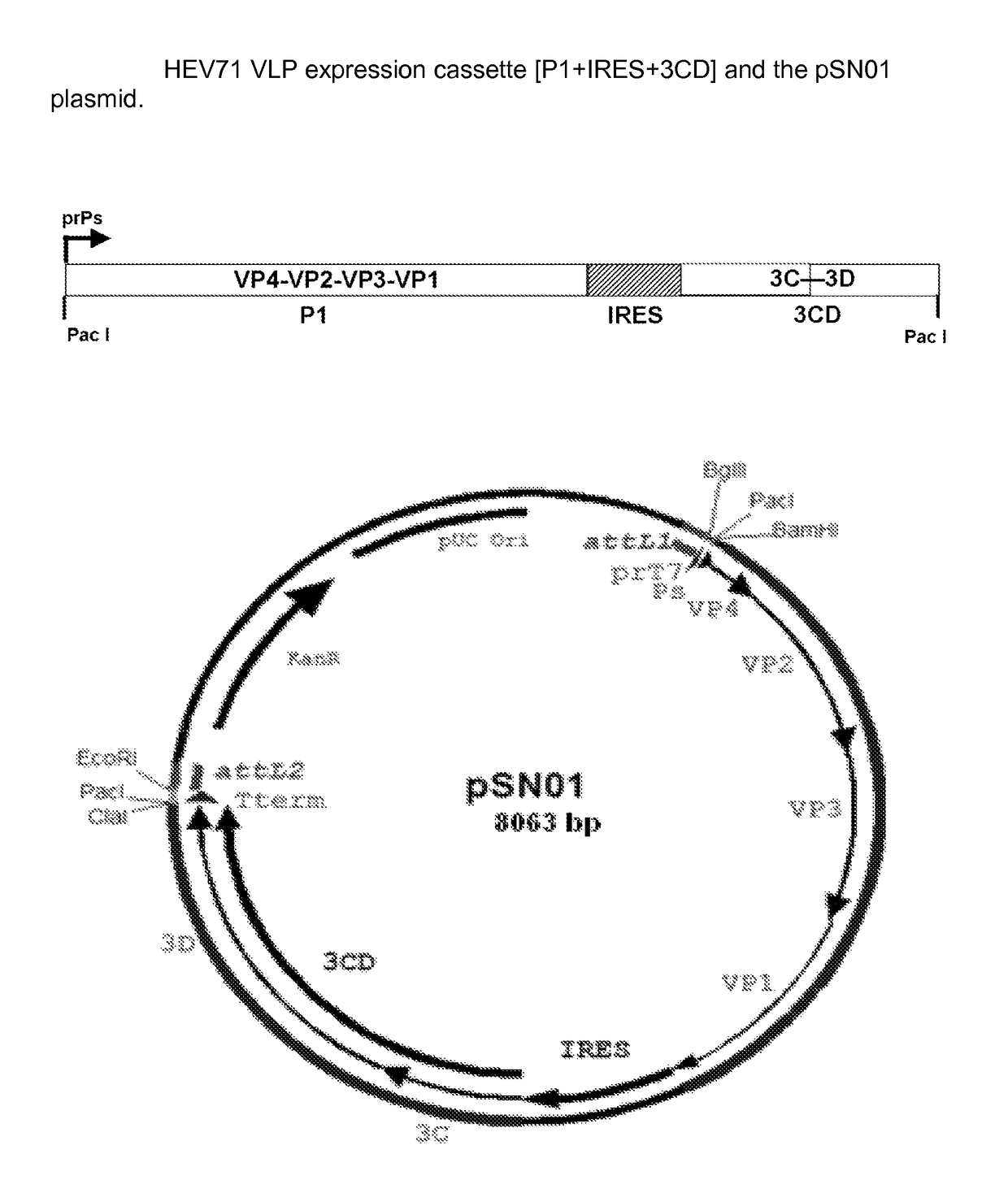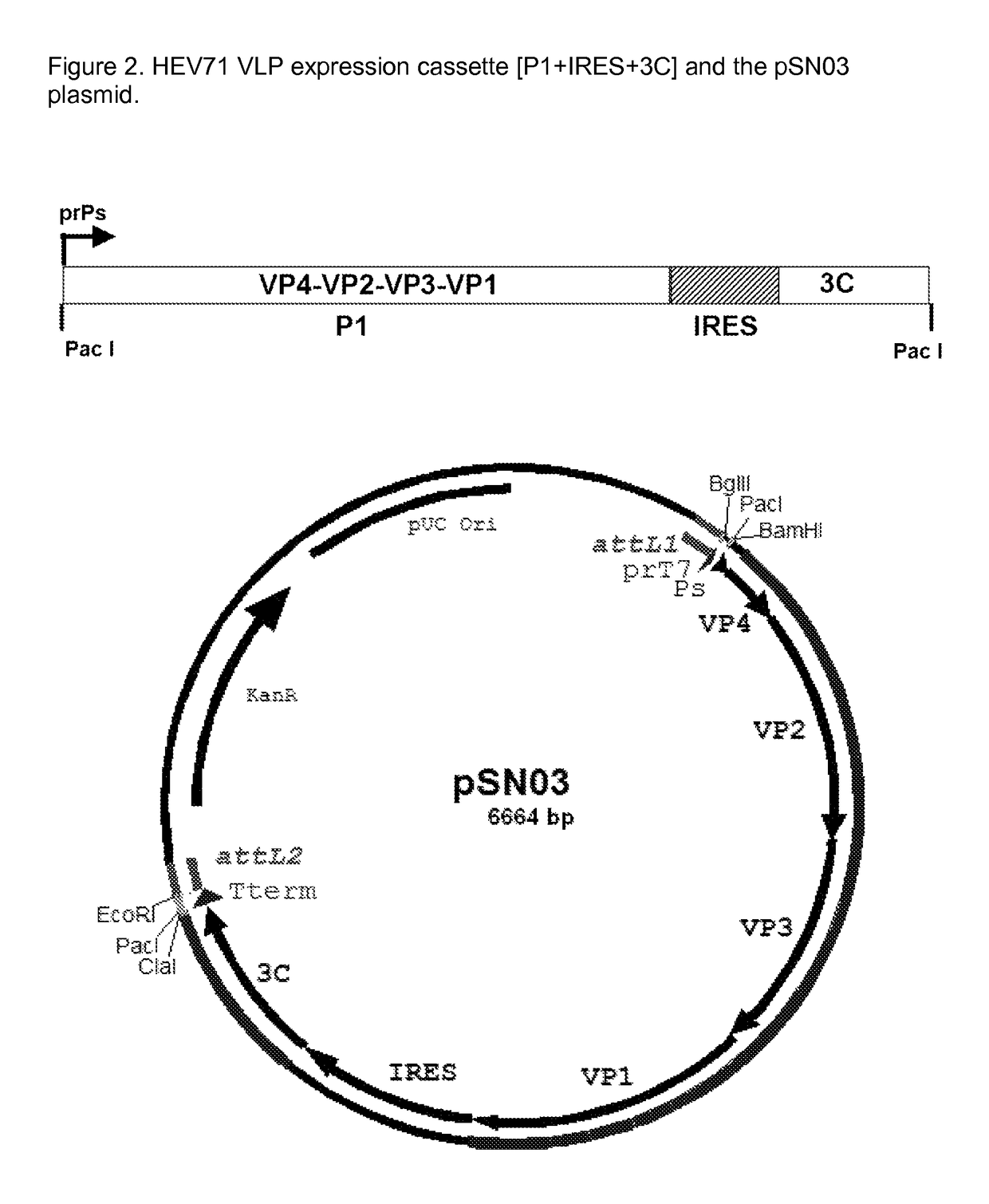Antigens and vaccines directed against human enteroviruses
a technology of enterovirus and antiviral antibody, which is applied in the field of antiviral antibody and vaccines, can solve the problems of no specific antiviral treatment of hfmd, no vaccine to prevent i>enterovirus, and attenuated human i>enterovirus /i>c may be dangerous
- Summary
- Abstract
- Description
- Claims
- Application Information
AI Technical Summary
Benefits of technology
Problems solved by technology
Method used
Image
Examples
example 1
Description of HEV71 VLP Expression Cassettes and Vectors
[0227]Expression cassettes may be constructed through means understood in the art.
[0228]1.1 HEV71 VLP Expression Cassette [P1+IRES+3CD]
[0229]Features:[0230]Cassette size: 5172 bp[0231]prPs: Pox virus strong early / late synthetic promoter, 43 bp[0232]P1: P1 protein coding sequence from EV71-SB12736-SAR-03 (GenBank Accession: DQ341362) with the addition of a stop codon, 2588 bp[0233]IRES: Internal Ribosome Binding site, 585 bp[0234]3CD: C and D protein coding sequence of P3 from EV71-SB12736-SAR-03 (GenBank Accession: DQ341362) with the addition of a ATG start codon and stop codon, 1940 bp[0235]Pac I: Rare cutters, enables cassette to be cloned into pSNX01 (MVA del 3 integration vector)[0236]The cassette was cloned into pDONR221 Gateway entry vector (Invitrogen) to produce pSN01.[0237]See FIG. 1 for a diagram of the expression cassette and the pSN01 plasmid.
[0238]1.2 HEV71 VLP Expression Cassette [P1+IRES+3C]
[0239]Features:[0240]...
example 2
Processed VP1 in Both the Supernatants and the Lysates
[0257]Sf9 cells were infected at a Multiplicity of Infection (MOI) of 10 with different recombinant baculovirus isolates, including SN07, SN08, a control baculovirus bacGUS and mock infected. Supernatants and lysates were harvested on days 3 and 4 post infection and expression of the proteins evaluated by Western blots using rabbit anti-VP1 antisera (1:4000 dilution) to compare yields of proteins produced by SN07 and SN08. As shown in FIG. 4, expression construct SN07 produced more cleaved VP1 than expression construct SN08 both in the supernatant and in the lysate on both days 3 and 4 post infection.
example 3
VP1 and VP0 is in the Retentate after Ultrafiltration Over a 100 kD Molecular Weight Cut Off (MWCO) Membrane
[0258]Supernatants from SN07 infected Sf9 cells at day 3 post-infection were clarified and were passed through AMICON® filters (Millipore Corp.) with a 100 kDa MWCO. The retentate was tested for the presence of processed VP1 and VP0. Since the molecular weight of VP1 is approximately 33 kDa, and the molecular weight of VP0 is 36 KDa, these proteins would not be expected to remain in the retentate unless they were in an oligomeric form. As shown in FIG. 5, these antigens remain in the retentate on passing the supernatants through a 100 kDa MWCO ultrafilter. This suggests that the antigens are associated in an oligomeric form. Thus, it may be concluded that VP1 and VP0 are processed and are in an oligomeric association with other capsid proteins.
PUM
| Property | Measurement | Unit |
|---|---|---|
| molecular weight cut off | aaaaa | aaaaa |
| temperature | aaaaa | aaaaa |
| temperature | aaaaa | aaaaa |
Abstract
Description
Claims
Application Information
 Login to View More
Login to View More - R&D
- Intellectual Property
- Life Sciences
- Materials
- Tech Scout
- Unparalleled Data Quality
- Higher Quality Content
- 60% Fewer Hallucinations
Browse by: Latest US Patents, China's latest patents, Technical Efficacy Thesaurus, Application Domain, Technology Topic, Popular Technical Reports.
© 2025 PatSnap. All rights reserved.Legal|Privacy policy|Modern Slavery Act Transparency Statement|Sitemap|About US| Contact US: help@patsnap.com



